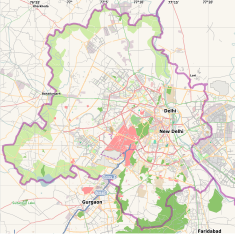Shish Gumbad
| Shish Gumbad | |
|---|---|
Lodhi Gardens | |
| Coordinates | 28°35′37.3884″N 77°13′12.6192″E / 28.593719000°N 77.220172000°E |
| Built | 1489-1517 CE |
| Architectural style(s) | Islamic & Hindu architecture |
| Governing body | Archaeological Survey of India & NDMC |
| Owner | Government of Delhi |
| Official name | Shish Gumbad |
| Designated | 9 Apr 1936 |
| Reference no. | N-DL-76 |
Shish Gumbad ("glazed dome"), also spelt Shisha Gumbad, is a
Shish Gumbad is situated in the
History
Exact date of construction of Shish Gumbad is not known. There are four monuments (tombs) in the
]Among historians there is no agreement, who are the occupants of the graves inside the structure. The Shish Gumbad might have been dedicated either to an unknown family, which was part of the
Initially, all the monuments were built independently and were not in one confine. In early 20th century, a park was developed which was inaugurated by Lady Willingdon on 9 Apr 1936 bringing the four monuments in one confine.[8]
Construction
Constructed between 1489-1517 CE, the Shish Gumbad is constructed in square shape. Combination of
The ceiling is decorated with plaster work that contains Quranic inscriptions and floral designs. The monument was originally decorated with blue enamelled tiles that shined like glass. The Gumbad hence got its name "Shish Gumbad". The blue tile embellishment presently only remains on top of the main frontage in traces.
Location
The Shish Gumbad is located in and is a part of the Lodhi Gardens in
Picture gallery
-
Monument information board displayed in Lodhi gardens.
-
Rear view of Shish Gumbad
-
Tiles on top of main entrance
-
Dome interior ceiling
-
Graves in main chamber
-
Carvings on South entrance
-
Shish Gumbad view from south (main entrance) side
-
Bara Gumbad Shish Gumbad
See also
- Bara Gumbad
- Lodhi Gardens
- Tomb of Bahlul Lodi
- Tomb of Sikandar Lodi
- Ibrahim Lodhi's Tomb
- List of Monuments of National Importance in Delhi
References
- ^ "Unknown Tomb". competentauthoritydelhi.co.in. Retrieved 15 October 2015.
- ^ a b "Who rests under that dome". The Hindu. Retrieved 15 October 2015.
- ^ a b "Tombs within Lodhi Gardens". Delhi information website. Retrieved 15 October 2015.
- ^ Expedia. Retrieved 15 October 2015.
- ^ ISBN 9789351941255. Retrieved 15 October 2015.
- ^ a b Simon Digby, The Tomb of Buhlul Lodi, The Bulletin of SOAS, Vol. 38, No. 3, 1975, pp. 550–61.
- ^ "Alphabetical List of Monuments in Delhi". Archaeological Survey of India. Retrieved 15 October 2015.
- ^ a b c "Important gardens" (PDF). New Delhi Municipal Council. Archived from the original (PDF) on 10 December 2015. Retrieved 15 October 2015.
- ^ "Bara Gumbad". orientalarchitecture.com. Retrieved 15 October 2015.
- ^ C.E. Bosworth, The New Islamic Dynasties, (Columbia University Press, 1996), 304.
- ^ "Ten sites in Delhi you must visit". Zee News. Retrieved 15 October 2015.
- ^ "Bystanders of the past". The Hindu. Retrieved 15 October 2015.
- ^ "Lodhi Gardens, New Delhi". fiftyplustravels.com. Retrieved 15 October 2015.









